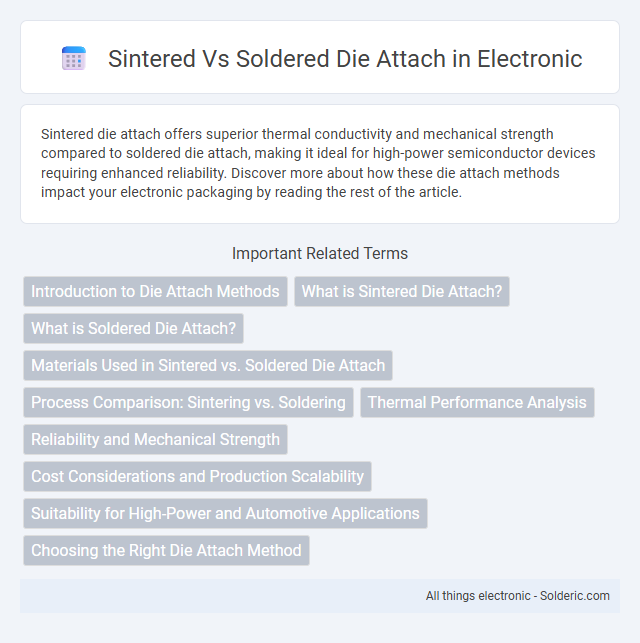Sintered die attach offers superior thermal conductivity and mechanical strength compared to soldered die attach, making it ideal for high-power semiconductor devices requiring enhanced reliability. Discover more about how these die attach methods impact your electronic packaging by reading the rest of the article.
Comparison Table
| Feature | Sintered Die Attach | Soldered Die Attach |
|---|---|---|
| Bonding Method | Pressure and heat-based sintering of metal particles | Melting and solidification of solder alloy |
| Thermal Conductivity | High thermal conductivity (up to 150 W/m*K) | Moderate thermal conductivity (~50-60 W/m*K) |
| Mechanical Strength | Strong, robust bond with high shear strength | Good bond strength, but prone to fatigue |
| Processing Temperature | High temperature (~250-300degC) | Lower temperature (~180-250degC) |
| Reliability | Excellent for high-power and high-reliability applications | Suitable for standard electronic assemblies |
| Typical Materials | Silver-based pastes or powders | SnAgCu, SnPb solder alloys |
| Application | Power semiconductors, automotive, aerospace | Consumer electronics, PCB assemblies |
| Cost | Higher due to materials and processing equipment | Lower and widely accessible |
Introduction to Die Attach Methods
Sintered and soldered die attach methods are essential techniques in semiconductor packaging, ensuring reliable thermal and electrical connection between the die and substrate. Sintered die attach uses nano-silver particles that fuse under pressure and heat, offering superior thermal conductivity and mechanical strength compared to traditional soldering. Your choice between these methods impacts device performance and longevity, especially in high-power and high-reliability applications.
What is Sintered Die Attach?
Sintered die attach is a process that uses metal powders, typically silver, compacted and heated below their melting point to form a strong, conductive bond between the semiconductor die and the substrate. This method offers superior thermal conductivity and mechanical strength compared to traditional soldered die attach, making it ideal for high-power and high-temperature applications. Your devices benefit from enhanced reliability and performance due to the robust connection sintered die attach provides.
What is Soldered Die Attach?
Soldered die attach is a semiconductor packaging method where the die is bonded to the substrate using a metal alloy that melts at a specific temperature, creating a strong, thermally conductive joint. This technique provides excellent electrical and thermal conductivity, making it ideal for high-power or high-frequency applications. Compared to sintered die attach, soldered joints tend to offer lower mechanical strength but are easier to rework and have well-established processing parameters.
Materials Used in Sintered vs. Soldered Die Attach
Sintered die attach utilizes nano-silver particles that sinter under heat and pressure, forming a highly conductive and reliable bond ideal for high-power semiconductor devices. Soldered die attach commonly employs tin-lead or lead-free solder alloys containing elements like tin, silver, and copper, providing good thermal and electrical conductivity but with lower mechanical strength compared to sintered joints. Your choice between these materials depends on device performance requirements, with sintered materials offering superior thermal conductivity and mechanical robustness.
Process Comparison: Sintering vs. Soldering
Sintered die attach employs high-pressure, high-temperature processes to bond silver particles, creating a robust, thermally conductive interface ideal for high-power semiconductor devices. Soldered die attach uses melting and solidification of solder alloys, offering lower processing temperatures but potentially reduced thermal performance and mechanical strength. The sintering process generally results in enhanced reliability and thermal management compared to soldering, making it preferable for advanced power electronics applications.
Thermal Performance Analysis
Sintered die attach offers superior thermal conductivity compared to soldered die attach, enabling more efficient heat dissipation in high-power semiconductor devices. The porous structure of sintered silver provides lower thermal resistance and maintains mechanical integrity under thermal cycling, enhancing device reliability. In contrast, soldered die attach typically exhibits higher thermal resistance and may degrade faster at elevated temperatures, limiting its performance in demanding applications.
Reliability and Mechanical Strength
Sintered die attach offers superior reliability and mechanical strength due to its ability to create a dense, void-free intermetallic bond, which enhances thermal conductivity and withstands high thermal cycling stress. Soldered die attach, while simpler to process, often exhibits lower mechanical strength and may be prone to voids and fatigue under repeated thermal expansion. Consequently, sintered die attach is preferred for high-power and high-reliability applications where mechanical robustness and long-term stability are critical.
Cost Considerations and Production Scalability
Sintered die attach offers higher upfront equipment costs but provides superior thermal and mechanical performance, making it cost-effective for high-volume production runs due to reduced failure rates and increased yield. Soldered die attach generally has lower initial material and equipment expenses, making it suitable for small to medium production scales with simpler process requirements. Production scalability favors sintered attach for advanced applications requiring reliability and efficiency, while soldered attach remains more flexible and economical for lower volume manufacturing.
Suitability for High-Power and Automotive Applications
Sintered die attach offers superior thermal conductivity and mechanical strength, making it highly suitable for high-power and automotive applications that demand reliable heat dissipation and durability under harsh conditions. Soldered die attach provides good electrical conductivity and ease of processing but may lack the thermal performance and long-term reliability required for heavy-duty automotive environments. Choosing sintered die attach enhances Your device's efficiency and longevity in power-intensive automotive systems.
Choosing the Right Die Attach Method
Selecting the optimal die attach method depends on factors such as thermal conductivity, mechanical strength, and application environment. Sintered die attach offers superior thermal performance and reliability for high-power devices, while soldered die attach provides easier processing and cost-effectiveness for less demanding applications. Assessing device requirements, production scalability, and long-term performance ensures the right balance between efficiency and durability in semiconductor packaging.
Sintered vs Soldered die attach Infographic

 solderic.com
solderic.com